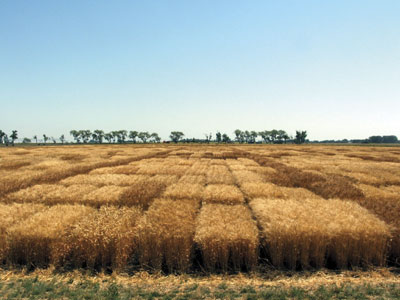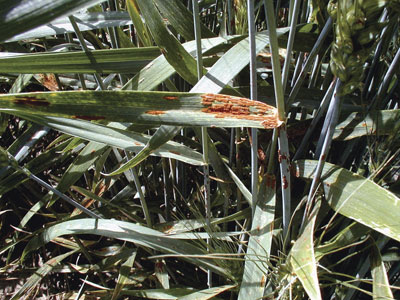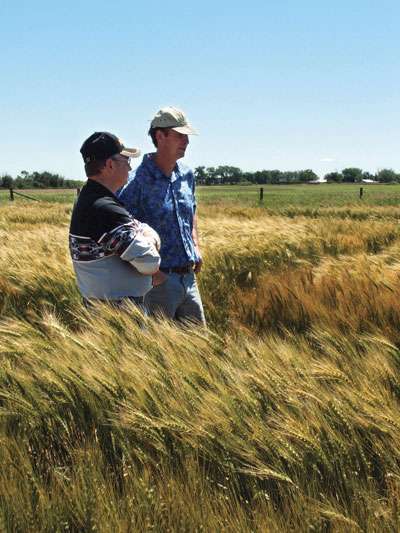
Features
Agronomy
Plant Breeding
Creating better winter wheats for Western Canada
Improved varieties of winter wheat provide important economic advantages for growers, explains Alex Russell, a longtime grower and past chair of the Lethbridge region for the Alberta Winter Wheat Producers Commission.
October 22, 2009 By Carolyn King
Improved varieties of winter wheat provide important economic advantages for growers, explains Alex Russell, a longtime grower and past chair of the Lethbridge region for the Alberta Winter Wheat Producers Commission. “If you have a good variety that’s a good fit agronomically for your farm, then you’ll spend less money on inputs for disease and insect control and have fewer problems with issues like harvestability.
 |
|
| Some of Graf’s experimental winter wheat lines at the main breeding site at AAFC Lethbridge. Photo courtesy of Dr. Robert Graf, AAFC. |
Varieties with increased yields for the same inputs are important for long-term economic viability of farms in Western Canada. And varieties with the quality needed for the markets you’re after are important. With changing customer demands, changing markets, you need to have breeders who have foresight to breed years ahead, to see where trends are going and what’s important for farmers.”
Agriculture and Agri-Food Canada’s winter wheat breeding program based in Lethbridge is focusing on all those angles: agronomics, disease resistance and quality, with the goal to develop improved varieties for the Prairie and Parkland regions of Alberta, Saskatchewan and Manitoba. “The winter wheat program here at Lethbridge is the longest running winter wheat breeding program in Western Canada,” says Dr. Robert Graf, who has been leading the program since 1999. “Breeding started here in the late 1940s, and there was screening going on long before that.”
Through the efforts of Graf and other Canadian breeders, winter wheat varieties have come a long way. He says, “Fifteen years ago the predominant variety in Western Canada was Norstar. It has excellent winter hardiness, good stress tolerance and very good quality. But it has very little if any disease resistance and it tends to be tall and weak strawed. So as winter wheat acreage expanded from southern Alberta north into the Parkland and east into the higher rainfall areas of the Black soil zones in Saskatchewan and Manitoba, Norstar was not very well suited. It was too tall so it lodged severely, and it was prone to attack by stem rust.
“Today we have varieties that have very good leaf and stem rust resistance. We have another variety that has good bunt resistance. And we have a variety with wheat streak mosaic resistance, that being Radiant (from the Lethbridge program), which has wheat curl mite resistance. And all of our current varieties are semi-dwarfs that have much better straw strength.”
Further developments, more opportunities
With that solid foundation, Graf’s program is now addressing the challenge of creating varieties that have resistance to several diseases along with a full complement of desirable agronomic and quality traits. On top of that, the program aims to develop varieties for all of Western Canada, although some may be better suited to specific regions. Promising lines are tested at sites across the Prairies: in Alberta at Lethbridge, Warner, Olds, Lacombe, and Beaverlodge; in Saskatchewan at Saskatoon, Indian Head, Swift Current, Melfort and Watrous; and in Manitoba at Brandon, Carman and Rosebank.

|
|
| Developing stem and leaf rust resistant varieties is among the many goals of the program. Photo courtesy of Dr. Robert Graf, AAFC. |
The program has a remarkable array of breeding objectives. The agronomic objectives include increased yield, maintained or increased winter hardiness, moderate to short strong straw, early to medium maturity (in the range from CDC Falcon to AC Radiant), and other characteristics such as high test weight, large seed size, stress tolerance and resistance to shattering.
The disease and insect pest objectives include several issues. Graf says, “We are developing lines with good leaf and stem rust resistance, which is particularly important for the Eastern Prairies. We’re also developing lines that have good stripe rust resistance. A couple of years ago, there was an outbreak of stripe rust on the Prairies and we very rapidly found out we don’t have a lot of resistance to it. That’s important in both the Eastern and Western Prairies. We’re also working on resistance to fusarium head blight, wheat streak mosaic and common bunt. And more recently we’ve started to work on incorporating resistance to wheat stem sawfly because that looks like it could be an up and coming pest in winter wheat so we want to be at least part of the way along in developing solid stem lines when this new biotype of the wheat stem sawfly arrives on our doorstep.”
The program’s quality component has two major objectives. One is to develop red winter wheat varieties with good milling and baking characteristics that meet the Canadian Wheat Board’s Identity Preserved (IP) requirements. The other is to develop General Purpose winter wheat varieties for the feed and ethanol markets. Because quality is not the issue for the General Purpose varieties, Graf is focusing on incorporating as much disease resistance as possible into very high yielding lines.
The program is working on two other quality areas Graf thinks could pay off in the long run: red winter wheats with CWRS quality, and hard white winter wheats.
For the hard white winter wheats, he hopes to combine the premium quality of a red winter with a white colour. That would allow access to the Asian noodle market and to markets for whole wheat products that children prefer. Graf explains, “The red colour in the bran (of the red wheats) is imparted by phenolic compounds that give the bran a bitter taste that children don’t like. With hard white wheats you can manufacture whole wheat flour without those phenolic compounds. There are some reports that the bread actually tastes sweeter.”
Graf’s program puts winter wheat lines into the registration trials every year. Since 1990 five varieties developed through the program have been registered.
The main funder for the program is AAFC itself. The program also receives funds from the Western Grains Research Foundation (WGRF) and from Ducks Unlimited Canada, which are matched by AAFC’s Matching Investment Initiative.
In the future, the provincial winter wheat commissions in Alberta, Saskatchewan and Manitoba are set to play increasingly important roles. Graf collaborates with other AAFC researchers and other breeding programs in Western Canada for testing of his breeding lines. For example, he collaborates with Dr. Anita Brule-Babel at Winnipeg for stem and leaf rust screening while Dr. Radhey Pandeya at AAFC in Ottawa does inoculation and screening of Graf’s lines to test for resistance to fusarium head blight. “We have at least a dozen different collaborators,” Graf explains.
| One grower’s wish list
Alex Russell and his family have been growing winter wheat for more than 40 years. They are currently growing AC Readymade and AC Radiant, which both came out of the Lethbridge program. Russell’s own wish list for future winter wheat varieties includes several traits that are part of Dr. Robert Graf’s program, such as spring wheat-like quality and resistance to wheat stem sawfly. Breeding for multiple traits Winter wheat can help crop rotations |
